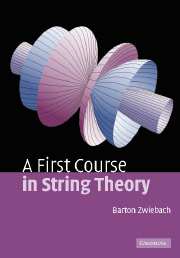Book contents
- Frontmatter
- Contents
- Foreword
- Preface
- Acknowledgements
- Part I Basics
- Part II Developments
- 14 D-branes and gauge fields
- 15 String charge, electric charge, and particle physics
- 16 String thermodynamics and black holes
- 17 T-duality of closed strings
- 18 T-duality of open strings
- 19 Electromagnetic fields on D-branes
- 20 Nonlinear and Born–Infeld electrodynamics
- 21 Covariant string quantization
- 22 String interactions and Riemann surfaces
- 23 Loop amplitudes in string theory
- References
- Index
19 - Electromagnetic fields on D-branes
from Part II - Developments
- Frontmatter
- Contents
- Foreword
- Preface
- Acknowledgements
- Part I Basics
- Part II Developments
- 14 D-branes and gauge fields
- 15 String charge, electric charge, and particle physics
- 16 String thermodynamics and black holes
- 17 T-duality of closed strings
- 18 T-duality of open strings
- 19 Electromagnetic fields on D-branes
- 20 Nonlinear and Born–Infeld electrodynamics
- 21 Covariant string quantization
- 22 String interactions and Riemann surfaces
- 23 Loop amplitudes in string theory
- References
- Index
Summary
We now begin a study of D-branes that carry electric or magnetic fields on their world-volume. Open strings couple to these electromagnetic fields at their endpoints. Using the tools of T-duality we show that a D-brane with an electric field is physically equivalent to a moving D-brane with no electric field. The constraint that a D-brane cannot move faster than light implies that the strength of an electric field cannot exceed a certain maximum value. We also show that a Dp-brane with a magnetic field is T-duality equivalent to a tilted D(p − 1)-brane with no magnetic field. Alternatively, the magnetic field on the Dp-brane can be thought of as being created by a distribution of dissolved D(p − 2)-branes.
Maxwell fields coupling to open strings
Among the quantum states of open strings attached to a D-brane we found photon states with polarizations and momentum along the D-brane directions. We thus deduced that a Maxwell field lives on the world-volume of a D-brane. The existence of this Maxwell field was in fact necessary to preserve the gauge invariance of the term that couples the Kalb–Ramond field to the string in the presence of a D-brane. We also learned that the endpoints of open strings carry Maxwell charge.
Since any D-brane has a Maxwell field, it is physically reasonable to expect that background electromagnetic fields can exist: there may be electric or magnetic fields that permeate the D-brane.
Information
- Type
- Chapter
- Information
- A First Course in String Theory , pp. 425 - 441Publisher: Cambridge University PressPrint publication year: 2004
